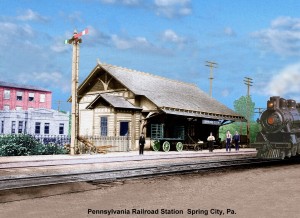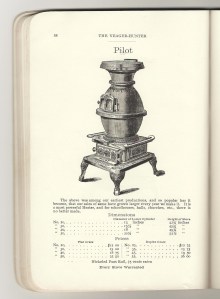This is the Pilot No. 55, just restored after about 127 years! Lookin’ pretty good, huh?
We couldn’t find anything about it, except what it said on the stove itself: “Penna Stove & Range Co., Spring City, PA. ” So, what’s it doing here in N. Carolina? And, why does it have a railroad spike for a door handle?
Ok, it is a large potbelly stove, standing 52″ high, and with a big 19″ fire pot – the type you would expect to have seen in a general store, back in the 1920’s? That’s what we thought at first glance, but, this stove has more history to it, even than that. Just a matter of finding it!
Well, here is what the Pilot looked like when we got it this past September at auction:
The unusual mica windows had been painted over, and it was missing part of the vent door slider at the bottom, (which had a little daisy flower patterned into the cast iron). But, it did have all its other parts, including its bootrails.
We later found out from its original advertisement, that nickel plating for the bootrails would cost the buyer an extra 75 cents…! These days it is way different, as nickel itself has become rather expensive, and preparing the cast iron for plating is a very specialized art.
We also found, from the Historical Society of Royersford and Spring City, PA, that the maker of the Pilot was the Yeager Hunter Stove Company of Spring City. The original stove foundry was built in 1843, and after several different owner/manufacturers, was then destroyed by fire in 1856. The people of the town of Spring City got together and rebuilt the stove factory in 1860, on the same site.
The foundry changed ownership a few more times, until finally Oliver Keeley owned it completely by the Spring of 1881. Unfortuately, once again the foundry was destroyed by fire in July of the same year. So, Mr. Keeley continued operations across the river in Royersford. But, in January 1882, he was killed in a train accident at age 36. The towns of Spring City and Royersford, had both the Pennsylvania RR and the Reading RR serving their locale.
After that, the people of the town got together once again, formed the Spring City Iron Association, and rebuilt the Spring City plant that had burned, on the same site. In 1883, they built a large 4 story warehouse and foundry with a machine shop and offices. Yeager and Hunter leased the plant for the next seven years, from 1883 – 1890. In 1890, they bought it and incorporated it as Yeager & Hunter, Spring City Stove Works. Today, it is known as “The Spring City Electrical Manufacturing Company”. They make cast iron lamp posts and use electrical power for the furnaces.
Many thanks to Bill at the Spring-Ford Area Historical Society for the historical records about the Pilot. Their website is: http://springcitypa.net/sfahs/ Bill Brunner can be reached at wcb604jlb@aol.com.
We thought it might have been used to heat a railroad depot in Spring City. Bill sent us the picture of the Spring City railroad station:




Very Nice Website I have marked it in My Favorites !
The small railroad spike used on the Pilot stove could have been a spike from the local Spring City trolley tracks. This line ran right down Main Street past the stove works and was operated from 1899 until 1924. The spikes are much smaller than the ones used on the local railroad mainline.
By: William C. Brunner on November 22, 2010
at 5:18 pm
That is great to know! So, that explains why the spike is so much smaller than a normal railroad spike. And, the time period would be at the time the Pilot was being produced and offered for sale. It was not the usual knob offered for the stove door, so, someone specifically put it there, very accurately. I would say it is a worthwhile historical addition to the Pilot.
By: gingercreekstoves on November 24, 2010
at 6:44 pm
I just got a #35 , it is very similar to the #55
The #35 top door has 3 vents with a 4″dial and the boot rails are not Nickle plated,
but everything else looks the same.
Do you have any info on a #35 stove.
By: sam on December 19, 2010
at 7:50 pm
Usually, stove manufacturers would make the same model in different sizes. So, the #35 could be a smaller version the #55. Or, it could be a much newer stove. Nickel plating on the boot rails was often optional, and the cost would have been something like 75 cents extra! It’s important to note what exactly is written on the stove itself. Does it say ‘Penna Stove & Range Co., Spring City, PA”? Or, something else?
Different stove companies also used the same ‘name’ for their stoves. ‘Pilot’ seems to have been a popular stove name. They also seemed to share some of the same stove casting moulds, at times. So, since it has vents on the top door, it may be a completely different stove company that made it. The Pilot by Penna Stove & Range Co. of Spring City, PA, only has two large mica windows for its top door.
We have also heard that a very similar stove to the Pilot was made by Keeley Stove Co. of Columbia, PA, which would have been a later manufacture. And, notably, according to antique stove historian, Nollie Neill, a stove named ” The Pilot’ was also made by Southern Stove in Richmond VA,- and it was sold by Glascock in the early catalogs as the ‘Pilot,’ -Southern called it the Pilot or the Tidewater.”
So, it is important to discern which ‘Pilot’ it is that you have. Your answer is probably written somewhere on the stove itself.
By: gingercreekstoves on December 20, 2010
at 6:51 pm
Yes it say’s Penna. Stove & Range. Spring City Pa.
My guess Is that The 35 is part of the pilot line of Stoves and that the 55 (Being a higher # ) is a more optioned stove with the window and the Nickel plated boot rails.
All of the scroll work and the bottom door, the boot rails and the ring trim where the top and bottom halves meet, are the same as your #55.
This #35 came from a small town in Pa. called Jim Thorpe.
By: sam on December 21, 2010
at 10:42 am
Then it was made by the same manufacturer, probably around the same time, between 1883 and 1890. The #35 is likely smaller than the #55. The Pilot No. 55 is 52″ high, with a 30″ base and a 20″ firepot. Sometimes some decorative elements have been a little different on original advertisements at different times, for the Pilot – not sure why that is. Send us a picture of your stove and we’ll post it.
By: gingercreekstoves on December 21, 2010
at 3:54 pm
I’m not sure there is any connection between one Keeley Stove Co. and the other, later one — at least, don’t know what it is. In 1881, Oliver B. Keeley of Shantz & Keeley, Spring Cit, PA, was a member of the National Association of Stove Manufacturers, but he doesn’t show up any later than that, because he was killed in a train accident in New York City the following year, aged only 36.
The Keeley Stove Co. shows up in the NASM records for the first time in 1883, and remains in membership until 1924, fm the Columbia, PA address. The first of their cataogues that I’ve seen dates from 1886, and gives their foundry address as 2nd & Maple, Columbia PA, with a salesroom at 2nd & Race in Philadelphia, and a “General Southern Agent” at 10 S. Charles St., Baltimore. In their 1889 catalogue they spell out that they are successors to “Smith, Francis & Wells, Smith, Wells & Co., Smith, Johnson & Co., Shantz & Johnson, Shantz & Keeley, O.B. Keeley & Co. ,” i.e. they have acquired the latter’s patterns and will supply repairs (spare parts).
The officers in 1889 were S.S. Detwiler (Pres.), G.W. Haldeman (Treas.), and S.T. Dickinson (Manager) — and there’s a nice picture of the factory in the front of the catalogue, which I would post here if I knew how (could do it on my own blog instead).
By: Howell Harris on December 22, 2010
at 11:57 am
This is a late reply as it is now October 2015. I ran across an article at lancasterhistory.org . In 1881 Mr. Keeley took over full ownership at the Spring City Stove Co. in Montgomery County, PA. After the fatal train wreck took his life in 1882, the estate sold the company to a group of investors in Columbia, PA. In May 1882 they chartered as a stock corporation called The Keeley Stove Company and continued to operate the Spring City plant until a new factory was built in Columbia, PA, which was finished and opened in February, 1883. It remained in business until 1948.
I have a small “pot belly” stove marked “The Keeley Stove Co”…….Columbia and Phila. PA. (Spring City being right out side Philadelphia).Since both locations are listed, I am assuming my stove was made around 1882-83.
The stove is unusual in that the basketball-sized potbelly is made up of dozens of small windows much like a base burner stove.
By: Steve Elliott, Pennsburg, PA on October 3, 2015
at 6:20 pm
Thanks for sharing the history on Keeley Stove. It would be interesting to see a picture of your stove. If you want to send one to our website email I’ll try to post it here – not sure if I can post it in with the comments but I’ll try. info@gingercreekstoves.com
By: gingercreekstoves on October 5, 2015
at 7:14 am
Hi, need help with our new edition. Brought home a stove with writing, The Keeley Stove co. Columbia, Pa. On the top and On the front sliding door it says Columbian Pilot No 10. Can’t find any history on this one. Any help?
Jill
By: Jill on July 4, 2016
at 10:02 am